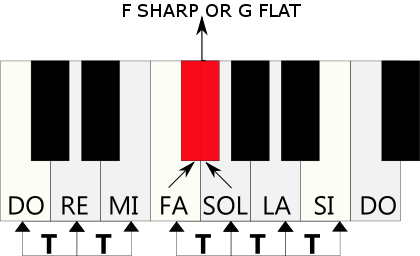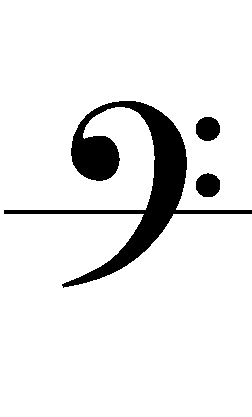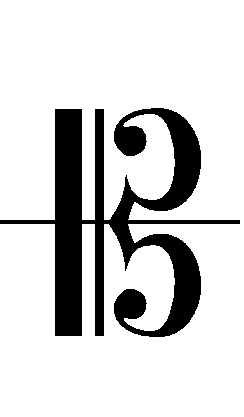1.1 Notes
One of the most significant events in the evolution of music was the selection, from the infinite variety of sounds, of a limited series of sounds to be used in practice. Thus we have notes named as follows:
A B C D E F G
On the piano keyboard these notes are distributed as follows:

1.2 The octave
The notes on the piano keyboard are ordered from lowest to highest, from left to right.
If we play a key that produces the note C and another one eight notes to the right of it, we obtain an interval (the distance between two notes) known as the octave. This interval is the distance between two notes of the same name where the higher note is twice the frequency of the lower note.For example, if the lower C has a frequency of 261 Hz then the next C above it will have a frequency of 522 Hz and so on. The octave is universally recognised as the easiest interval to pitch because, to our ears, the two sounds in combination sound so similar.
In different periods and cultures the octave has been subdivided in different ways: in Chinese music, for example, the octave is subdivided into five pitches, in Arabic music into seventeen and, in Western culture, it is subdivided into twelve equally spaced pitches and the interval between one of these pitches and its neighbour is know as the semitone (1).
1.3 The semitone.
The semitone is the smallest interval used in traditional Western music. The keys of a piano are tuned in semitones, as shown in the diagram. The sum of two semitones is a tone.

On a keyboard the black keys are named relative to their adjacent white keys, using the terms sharp and flat. For example, the black note next to the note F may be called either F sharp or G flat. Two notes that have the same sound but are "spelt" differently, as in the case of F sharp and G flat, are described as being enharmonic.
There are two types of semitone:
- Chromatic when both notes have the same letter name, e.g. C and C sharp;
- Diatonic when the two notes have different letter names, e.g. E and F or A and B flat.
1.4 The staff
In printed music notes are represented by small circular symbols on a set of parallel horizontal lines known as a staff. (2)
The staff consists of five lines and four spaces.

Notes can be written on either the lines or the spaces. Notes may also be written above or below the staff on ledger lines.
1.5 Clefs
At the beginning of each staff, on the left, a clef is written..A clef is a symbol that fixes a particular line of the staff to mean a particular note which then becomes the point of reference for all the other notes written on that staff. Our system uses three types of clef (3):
| Treble clef or G clef |  |
| Bass clef or F clef |  |
| C clef |  |
The names G clef, F clef and C clef derive from the names of the notes that each clef fixes.
Whichever line the clef is placed on will then be fixed as representing that note. These are the only clefs used in the UK.
| The G clef, commonly known as the treble clef, is placed on the 2nd line of the staff. |  |
| When the C clef is placed on the 3rd (middle) line of the staff it is known as the alto clef. |  |
| When the C clef is placed on the 3rd (middle) line of the staff it is known as the alto clef. |  |
| When the C clef is placed on the 4th line of the staff it is known as the tenor clef. |  |
| The F clef, commonly known as the bass clef, is placed on the 4th line of the staff. |  |
Clefs in braille
Notes may also be written outside the staff, but in this case they must be written on ledger lines which may be though of as fragments of further lines above or below the normal five of the staff.
In some cases, in order not to make reading the music too difficult because of multiple ledger lines, the "Octave above" or the "Octave below" signs can be used.

There are conventions for denoting which octave a note is in. The commonest is to number the octaves, starting from the note C, from the lowest on the piano keyboard (octave 1) to the highest (octave 7). On an 88-note keyboard the top C would, in fact, be the start of octave 8. The octave number for a note is written as a superscript. Middle C is the beginning of octave 4 and the A above it (440 Hz) is also part of octave 4.
1.6 The score
The score may be made of one, two, three or more staves. This depends mainly on the instrument being written for. The piano, for example, will normally have two staves, the organ three but a flute would only require a single staff. An orchestral score contains many staves but this will vary during the course of the piece according to which instruments are actually playing at any given point in the score.
parts and Braille
(1) Modern notation is not the invention of a single person, nor is it the result of a long collaboration. It has evolved over time, with input from many different people. The Greeks were the first to assign letter names to notes and they used the terms Phoenician and Ionian to denote instrumental and vocal music respectively. Later, the Romans substituted Latin letters for Greek ones and Odo of Cluny (9th - 10th century) championed the use of the modern alphabet. In the system known as tonic sol-fa the note names DO. RE, MI. FA. SOL, LA. SI corrispond to: C. D, E. F G, A, B. The series DO, RE, Ml, FA, SOL, LA, SI arose later on in the work of Guido d'Arezzo. He devised a mnemonic for singers using the first verse of St. John Paul the Deacon, using the first syllable of each line:
Ut queant laxis
Resonare fibris
Mira gestorum
Famuli tuorum
Solve polluti
Labii reatum
Sancte Joannis
The initial UT which is still used in France was transformed in Italy into DO in the works of, and in honour of, a Florentine theorist: Giovanni Battista Doni (1594 -1647).
(2) In ancient times, there was no need to write music precisely since, very often, the composer was also the performer. The composition, if interesting, was handed down "by ear" and signs were placed above the text that were nothing more than mnemonic devices for the singer or instrumentalist indicating a general contour of the melody but without any precision as to pitch or rhythm. This creates great difficulties in the interpretation of some old scores, because each school and each musician had different ways of notation, depending on their musical needs. Our modern system of musical notation is defined as diastematic in that it can indicate pitch precisely and makes use of musical staff with a clef (diastenia = space). Ancient music is often adiastematic - that is to say that it does not use any reference line, but put signs freely over the text. The introduction and development of the musical staff is attributed to Guido d'Arezzo, who was among the first to draw a line above the text along which, above or below, were written signs (neumes) which gave indications of melodic contour. Later the musical staff was enlarged by new lines, up to four, sometimes using different coloured inks to determine precise notes. Hence the birth of the tetragrammaton (staff of four lines) which is still used in the reading and interpretation of Gregorian music.
(3) The three clefs used in Western music are signs that symbolised the first letters of the Latin alphabet and, as happens today, they also determined the name of the note on the line on which they were marked. The treble clef is derived from the letter G, the bass clef is derived from the letter F, the C clef is derived from the letter C.
